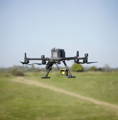No Products in the Cart
Drones improve oil and gas operations by providing faster, safer aerial inspections, real-time data insights, and minimizing risks in hazardous areas, ensuring efficiency and safety across challenging environments.
Drones can quickly cover large areas and provide high-resolution images and data, significantly speeding up inspections and surveys compared to traditional methods.
Drones allow for remote inspections of hazardous locations, reducing the risk to personnel and improving overall workplace safety by keeping workers away from dangerous environments.
Drones with gas sensors facilitate environmental assessments and monitoring, helping companies ensure compliance with regulations and assess the impact of operations on surrounding ecosystems.

Traditional methods often require personnel to enter hazardous environments, increasing the risk of accidents and exposure to harmful conditions. These inspections can be time-consuming and costly, leading to prolonged operational downtime. Weather conditions and difficult terrain complicate the process, making it challenging to detect issues like leaks or structural damage promptly.

Thermal imaging plays a crucial role in oil and gas inspections by detecting temperature variations that indicate issues like leaks, blockages, or faulty equipment. With thermal cameras mounted on drones, inspectors can quickly scan pipelines, tanks, and processing facilities to identify hotspots or cold spots caused by fluid leaks, insulation problems, or mechanical failures. This technology is especially valuable for detecting gas leaks, which are invisible to the naked eye. Thermal imaging enhances safety by reducing the need for manual inspections in hazardous areas, improves maintenance planning, and helps prevent costly equipment failures or environmental damage.
Find the perfect solution for your needs.

By automating inspection and monitoring tasks, drones reduce long-term operational costs. They require less manpower and can cover large areas more quickly than traditional methods, leading to faster assessments and reduced downtime.

Drones can complete inspections in a fraction of the time it would take traditional methods. This efficiency enables quicker decision-making and response times, which is crucial for maintenance and emergency situations.

Drones are equipped with advanced sensors and cameras, allowing for high-resolution aerial imagery, thermal imaging, and real-time data collection. This precision helps in identifying leaks, monitoring equipment conditions, and assessing environmental impacts.

Drones can access hazardous and hard-to-reach areas, minimizing the need for personnel to enter potentially dangerous environments. This reduces the risk of accidents and injuries during inspections and monitoring.

Workers often face dangerous conditions such as low oxygen levels, toxic gases, and potential structural hazards while conducting inspections or maintenance in confined spaces. The physical limitations of these spaces can make it difficult for personnel to navigate and operate traditional equipment effectively.
Drones are a practical answer to the challenges of working in confined spaces within the oil and gas industry. They excel in low-visibility situations, delivering real-time data and high-quality images that help teams assess conditions without risking worker safety. Plus, drones can be deployed quickly, making operations more efficient and reducing downtime significantly.

Monitoring emissions in the oil and gas industry comes with its own set of challenges. The often remote locations of facilities, combined with the complex infrastructure, make it difficult to ensure continuous and accurate measurements. Traditional monitoring methods can be labour-intensive and time-consuming, which can delay the identification and response to potential leaks or emissions.


The oil and gas industry requires real-time data collection and analysis to detect leaks, equipment failures, or unauthorized activities. These are traditionally done using ground crews, manual inspections, or stationary monitoring systems, which can be time-consuming, costly, and often limited by access to remote or hazardous areas. This is where drones can streamline these activities by providing rapid, high-resolution aerial surveillance that covers vast areas quickly and efficiently.


Whether you need one-on-one or group training, our training programs provide the latest practical knowledge while keeping your budget in mind.
Looking to rent a drone to meet your evolving drone needs?
You'll find a wide range of industry-leading equipment, from DJI drones to advanced LiDAR systems at Measur. We offer cost-effective and convenient solutions for accessing high-quality drone technology without the commitment of ownership.

Give us a call or drop by anytime, we will answer all enquiries within 24 hours on business days. We will be happy to answer your questions.
We would love to hear from you! Our team is always here to help.
+1 866 300 9012
contact@measur.ca
Vancouver, British Columbia
Calgary, Alberta
Mississauga, Ontario
Montreal, Quebec